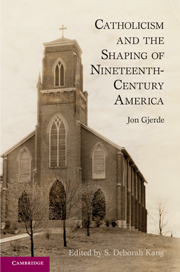Book contents
Editor’s Preface
Published online by Cambridge University Press: 05 June 2012
Summary
Jon Gjerde planned to both begin and end his manuscript for Catholicism and the Shaping of Nineteenth-Century America with an account of the 1844 anti-Catholic riots in Philadelphia. As a signal moment in the history of anti-Catholicism in the United States, the Philadelphia riots, as well as the violence that suffused the relationship between the nation’s Protestants and Catholics, figure prominently in historical accounts of American nativism. Gjerde recognized that he was treading on well-worn historical ground when he chose to remind his readers of the Philadelphia riots. But he did so in order to offer his own broad reinterpretation of the relationship between America’s Protestants and Catholics, arguing that an emphasis on the violence was “not wrong, but . . . must be clarified, enlarged, and probed further.” In Gjerde’s rendering, anti-Catholicism found expression in a less-violent register – in an enduring and frequently charged conversation between Protestants and Catholics about the fundamental underpinnings of the American state and society. This conversation, moreover, bore lasting consequences for the nation-building project in the nineteenth century and beyond. In Catholicism and the Shaping of Nineteenth-Century America, religious conflict did not serve only as a proxy for violence; in Gjerde’s words, it also reshaped “American religious and political life for years to come.”
- Type
- Chapter
- Information
- Catholicism and the Shaping of Nineteenth-Century America , pp. vii - xviiiPublisher: Cambridge University PressPrint publication year: 2011

